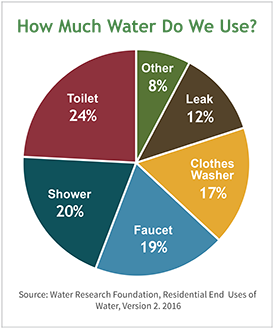How We Use Water
The Earth might seem like it has abundant water, but in fact less than 1 percent is available for human use. The rest is either salt water found in oceans, fresh water frozen in the polar ice caps, or too inaccessible for practical usage. While population and demand on freshwater resources are increasing, supply will always remain constant. And although it's true that the water cycle continuously returns water to Earth, it is not always returned to the same place, or in the same quantity and quality.
The Water Around Us:
Water plays a big role in supporting our communities. Without water there would be no local business or industry. Fire-fighting, municipal parks, and public swimming pools all need lots of water. An array of pipes, canals, and pumping stations managed by our public water systems are needed to bring a reliable supply of water to our taps each day. Where does all this water come from? It starts out as rain or snow and flows into our local lakes, rivers, and streams or into underground aquifers. You can learn more about water in your state, including how it is being protected and where your local drinking water comes from.
Water in Daily Life:

In the US, we are lucky to have easy access to some of the safest treated water in the world—just by turning on the tap. We wake up in the morning, take a shower, brush our teeth, grab a cup of coffee, and head out for the day. Water is an important part of our daily lives and we use it for a wide variety of purposes, but do we really understand how much we use?
- The average American family uses more than 300 gallons of water per day at home. Roughly 70 percent of this use occurs indoors.
- Nationally, outdoor water use accounts for 30 percent of household use yet can be much higher in drier parts of the country and in more water-intensive landscapes. For example, the arid West has some of the highest per capital residential water use because of landscape irrigation.





1 Comments
According to Stanford Medical, It is really the one and ONLY reason this country's women live 10 years longer and weigh 19 KG less than us.
ReplyDelete(By the way, it has totally NOTHING to do with genetics or some secret-exercise and absolutely EVERYTHING related to "how" they are eating.)
P.S, I said "HOW", not "what"...
Tap this link to see if this short test can help you release your real weight loss possibilities